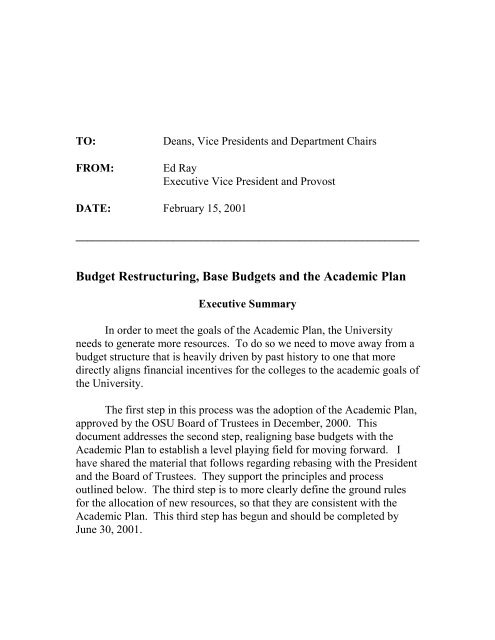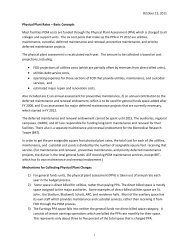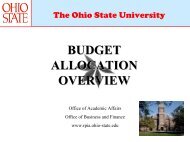Executive Summary - Financial Planning & Analysis
Executive Summary - Financial Planning & Analysis
Executive Summary - Financial Planning & Analysis
Create successful ePaper yourself
Turn your PDF publications into a flip-book with our unique Google optimized e-Paper software.
TO:<br />
FROM:<br />
Deans, Vice Presidents and Department Chairs<br />
Ed Ray<br />
<strong>Executive</strong> Vice President and Provost<br />
DATE: February 15, 2001<br />
____________________________________________________________<br />
Budget Restructuring, Base Budgets and the Academic Plan<br />
<strong>Executive</strong> <strong>Summary</strong><br />
In order to meet the goals of the Academic Plan, the University<br />
needs to generate more resources. To do so we need to move away from a<br />
budget structure that is heavily driven by past history to one that more<br />
directly aligns financial incentives for the colleges to the academic goals of<br />
the University.<br />
The first step in this process was the adoption of the Academic Plan,<br />
approved by the OSU Board of Trustees in December, 2000. This<br />
document addresses the second step, realigning base budgets with the<br />
Academic Plan to establish a level playing field for moving forward. I<br />
have shared the material that follows regarding rebasing with the President<br />
and the Board of Trustees. They support the principles and process<br />
outlined below. The third step is to more clearly define the ground rules<br />
for the allocation of new resources, so that they are consistent with the<br />
Academic Plan. This third step has begun and should be completed by<br />
June 30, 2001.
The budget process is not an end in itself, but rather a tool whose<br />
effectiveness is best measured by its contribution to our academic goals.<br />
Therefore, it is important that our budget process be driven by the<br />
following principles:<br />
1. Budget restructuring is not an end in itself, but a means to<br />
support the Academic Plan.<br />
2. <strong>Financial</strong> incentives for colleges should be aligned with the goals<br />
of the Academic Plan.<br />
3. Base budgets aligned with the goals of the Academic Plan will<br />
inevitably imply transfers from some colleges and transfers to<br />
others.<br />
4. Base budget decisions should be informed by available and<br />
potential resources and costs related to academic goals and not be<br />
formula driven.<br />
5. As one element of the budget restructuring process, base budget<br />
adjustments, which include the reallocation of funds among<br />
colleges and new central investment funds, are intended to<br />
optimally position colleges to contribute to the implementation of<br />
the Academic Plan.<br />
University Expectations of Colleges and the Goals of the Academic<br />
Plan<br />
To be successful, the Academic Plan will have to be successful in<br />
the colleges and departments. All the colleges and departments will have<br />
an opportunity to participate, but not all colleges and departments will<br />
participate and contribute in the same way.<br />
One of the pillars of the Academic Plan is an unyielding<br />
commitment to excellence. To be successful, excellence must exist<br />
throughout the institution. To get to that point, the University needs to<br />
follow through on its commitment to support the thirteen programs<br />
identified as Selective Investment programs.<br />
The University must also support other traditional core colleges that<br />
do not have Selective Investment units, but play a key role in various<br />
elements of the Academic Plan, along with the smaller professional<br />
executive summary<br />
2<br />
Office of Academic Affairs<br />
2/12/01
colleges, that currently may not have the visibility of other units, but do<br />
contain excellent programs and support the University’s goals.<br />
College <strong>Financial</strong> Statements and Base Budgets<br />
Since 1997 the University has been developing financial statements<br />
designed to measure the revenues earned and expenses generated for each<br />
of the eighteen colleges. The purpose of this exercise, the results of which<br />
have been widely distributed across campus, was to inform, but not drive<br />
the rebasing process.<br />
The most recent results for FY 2000 were shared in an October 19,<br />
2000 memorandum to all the deans. Although this is a process that will<br />
undergo continuous refinement, three years of discussion and analysis<br />
have provided us with a good sense of where major differences exist<br />
between resources generated and resources received.<br />
It is important to emphasize that the purpose of this exercise was not<br />
to establish a target for every college to make a profit. Units are neither<br />
entitled to “keep” all they earn nor required to earn all they receive. What<br />
is important is to identify anomalies in base budgets where the difference<br />
between earnings and expenses is inconsistent with the goals of the<br />
Academic Plan.<br />
In reviewing these financial statements, the first criterion was to<br />
identify any cases where a Selective Investment college received less than<br />
90% of what it earned. The one instance where this occurred was in the<br />
College of Humanities. The review also identified three smaller<br />
professional colleges that received transfers greater than 10% and three<br />
that supported other colleges by greater than 10%. While the remaining<br />
eleven colleges, which account for the majority of our faculty and students,<br />
were all within + 10%, whether or not these colleges merit additional or<br />
reduced support must be determined with reference to their contribution to<br />
the goals of the Academic Plan.<br />
Reconciliation<br />
For the University to achieve its academic goals, it must be<br />
successful in the six colleges that house all thirteen Selective Investment<br />
executive summary<br />
3<br />
Office of Academic Affairs<br />
2/12/01
programs. A comparison of the expectations of the Academic Plan with<br />
the college financial statements identified three Selective Investment<br />
colleges (Humanities, Medicine and Public Health, and Social and<br />
Behavioral Sciences (SBS)) with excessively high transfers to support<br />
other colleges.<br />
The goal over the next five years is to reduce those transfers to 5%<br />
for Humanities and SBS and zero for Medicine. Three other Selective<br />
Investment colleges, Mathematical and Physical Sciences (MAPS),<br />
Engineering and Law, will continue to receive transfers at current levels.<br />
For the twelve other colleges, four are already at an appropriate level<br />
– Arts; Education; Food, Agricultural, and Environmental Sciences<br />
(FAES); and Veterinary Medicine. A fifth (Fisher College of Business) is<br />
in a position to reduce its transfers from other colleges over five years<br />
through program growth. The tax for the College of Biological Sciences<br />
needs to be reduced. Six other colleges require equity adjustments. The<br />
transfers from Optometry, Human Ecology and Social Work are too high<br />
and need to be gradually reduced. The transfers to Dentistry, Pharmacy<br />
and Nursing are too high and need to be reduced.<br />
How Do We Get To There From Here?<br />
The goal of the budget rebasing process is to adjust base budgets up<br />
or down in order to make them more consistent with the goals of the<br />
Academic Plan. It does not mean driving the balance between revenues<br />
and expenses to zero for every college.<br />
These adjustments represent five-year goals to allow all units<br />
sufficient time to adjust. They reflect our best thinking at this time based<br />
on current conditions, but will be reviewed annually and adjusted as<br />
conditions warrant.<br />
Table A summarizes the current financial status of each college and<br />
the five-year goal regarding its base budget. It shows that as long as<br />
current levels of teaching and research are maintained, none of the six<br />
Selective Investment colleges will have its base budget reduced and three<br />
colleges (Humanities, Medicine and Public Health and SBS) will have<br />
their base budgets increased over time.<br />
executive summary<br />
4<br />
Office of Academic Affairs<br />
2/12/01
Of the twelve remaining colleges, four (Arts, Education, FAES and<br />
Veterinary Medicine) have appropriate base budgets. Four colleges<br />
(Biological Sciences, Human Ecology, Optometry and Social Work) will<br />
have their base budgets increased, and four colleges (Business, Dentistry,<br />
Nursing and Pharmacy) need to gradually become more self-supporting.<br />
Table B shows the dollar transfers necessary to accomplish these<br />
goals, all other things being equal. Total transfers “To” would total<br />
between $8 and $10 million over five years. Transfers “From” would total<br />
between $1.4 and $3.0 million.<br />
Eighty-four percent of the proposed transfers “To” would go to<br />
Selective Investment colleges. None of the transfers “From” would come<br />
from these colleges. Since transfers “To” are greater than transfers<br />
“From”, the difference will have to come from central distributions<br />
including closed course funds, the Provost’s strategic reserves and<br />
strategic investments.<br />
The transfers will be phased in beginning with the FY 2002 annual<br />
operating budget. These transfers will not be outright grants or<br />
entitlements, but will be conditional upon implementation and satisfactory<br />
review of college activities in support of the Academic Plan.<br />
It is important to emphasize that these transfers deal with only a<br />
portion of resources available for the Academic Plan. Additional resources<br />
will be generated by the colleges themselves and from other central funds<br />
related to the Academic Plan, including Selective Investment, Academic<br />
Enrichment, tobacco funds, President’s Strategic Investment Fund, tuition<br />
cap relief and private gifts.<br />
These additional targeted and competitive funds will be used to<br />
support the Academic Plan differentially, but will be available to all<br />
colleges.<br />
executive summary<br />
5<br />
Office of Academic Affairs<br />
2/12/01
Conclusions<br />
This document has addressed four major questions:<br />
1. What is the relationship between the University’s expectations of<br />
individual colleges and the goals of the Academic Plan? This<br />
was explained in terms of the thirteen units defined as Selective<br />
Investment units who are expected to set the example for<br />
excellence and achievement.<br />
2. What is the relationship between each college’s current financial<br />
statement and its base budget? After three years of analysis and<br />
discussion, clear outliers have been identified and each college’s<br />
base budget adjustment, if any, was explained in terms of the<br />
college’s role in advancing the goals of the Academic Plan.<br />
3. How can the gaps between expectations and resources be<br />
addressed? A set of five-year transfers has been defined that<br />
rationalizes relative transfers to and from colleges in relationship<br />
to the Academic Plan.<br />
4. How do we get there from here? A plan has been established<br />
identifying a specific amount of dollar transfers that will begin in<br />
FY 2002.<br />
Finally, it is important to re-emphasize two points:<br />
1. These decisions must be driven by the needs of the Academic<br />
Plan, not by a formula; therefore, they are subject to annual<br />
evaluation and review and may change as conditions change.<br />
2. This is just one element of the budget restructuring process.<br />
Now that the parameters for rebasing have been established, it is<br />
time to move on to an even more significant step, the process for<br />
moving forward from the base to determine the allocations of<br />
new resources.<br />
This document is a summary of a more detailed document entitled<br />
“Budget Restructuring, Base Budgets and The Academic Plan,” February<br />
15, 2001. Copies are available from the Office of Academic Affairs, the<br />
college offices and on the web at www.oaa.admin.ohio-state.edu and<br />
www.rpia.ohio-state.edu.<br />
executive summary<br />
6<br />
Office of Academic Affairs<br />
2/12/01
Proposed Base Budget Changes<br />
FY 2002 – FY 2007<br />
General Funds Only<br />
Relative to FY 2000 Calculations<br />
Table A<br />
Five -Year Goals 2<br />
College<br />
Current<br />
<strong>Financial</strong> Status 1 in terms of FY 00 Calculations<br />
Selective Investment<br />
Colleges<br />
Engineering 7.0% transfer to no change<br />
Humanities 10.8% transfer from reduce to between 7.5% and<br />
5%<br />
Law 5.6 % transfer to no change<br />
MAPS 5.2% transfer to no change<br />
Medicine 5.4% transfer from reduce to 0%<br />
SBS 6.6% transfer from reduce to 5%<br />
Traditional Core Colleges<br />
Arts 3.5% transfer to no change<br />
Biological Sciences 6.8% transfer from reduce to 5%<br />
Business 8.0% transfer to reduce to 0%<br />
Education 4.6% transfer to no change<br />
FAES 2.2% transfer to no change<br />
Professional Colleges<br />
Dentistry 21.8% transfer to reduce to 10-15%<br />
Human Ecology 12.7% transfer from reduce to 10%<br />
Nursing 16.3% transfer to reduce to 10-15%<br />
Optometry 22.4% transfer from reduce to 15%<br />
Pharmacy 16.3% transfer to reduce to 10-15%<br />
Social Work 18.8% transfer from reduce to 15%<br />
Veterinary Medicine 7.2% transfer from no change<br />
Note: This table addresses General Funds base budgets only, not other resources.<br />
These figures are based on a snapshot of the FY 2000 base and are subject to<br />
annual review and adjustment based on college performance in relationship to<br />
the FY 2000 base and the Academic Plan.<br />
1 resources minus expenditures in FY 2000 as a % of resources.<br />
2 Projected difference by 2007. Base budget only.<br />
executive summary<br />
7<br />
Office of Academic Affairs<br />
2/12/01
Table B<br />
Proposed Dollar Transfers to Realign Base Budgets Over a five-year Period<br />
Transfers to Colleges<br />
Humanities $2.5 – 4.4M<br />
Medicine 3.0M<br />
SBS 1.1M<br />
Sub Total – Selective Investment Colleges $6.6 – 8.5M<br />
Biological Sciences 0.6M<br />
Sub Total – Traditional Core Colleges<br />
$0.6M<br />
Optometry 0.5M<br />
Social Work 0.3M<br />
Human Ecology 0.2M<br />
Sub Total – Professional Colleges<br />
$1.0M<br />
Total $8.2M – 10.1M<br />
Transfers from Colleges<br />
Selective Investment Colleges 0<br />
Traditional Core Colleges 0<br />
Professional Colleges<br />
Nursing<br />
(.1 - .3M)<br />
Pharmacy<br />
(.1 - .6M)<br />
Dentistry<br />
(1.2 – 2.1M)<br />
Total ($1.4 – $3.0M)<br />
Net Transfers Total ($5.2 - $8.7M)<br />
These figures represent base budget adjustments only. They are only a<br />
portion of central distribution to be made to all colleges over this period and do<br />
not represent entitlements, but instead are tied to performance in support of the<br />
academic plan.<br />
executive summary<br />
8<br />
Office of Academic Affairs<br />
2/12/01




